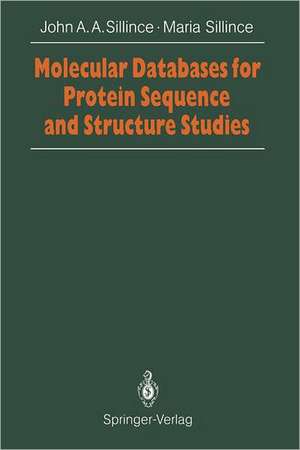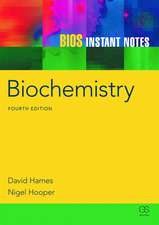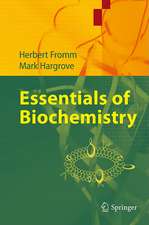Molecular Databases for Protein Sequences and Structure Studies: An Introduction
Autor John A.A. Sillince, Maria Sillinceen Limba Engleză Paperback – 22 dec 2011
Preț: 638.57 lei
Preț vechi: 751.25 lei
-15% Nou
Puncte Express: 958
Preț estimativ în valută:
122.20€ • 126.81$ • 102.14£
122.20€ • 126.81$ • 102.14£
Carte tipărită la comandă
Livrare economică 15-29 martie
Preluare comenzi: 021 569.72.76
Specificații
ISBN-13: 9783642768118
ISBN-10: 3642768113
Pagini: 260
Ilustrații: XVI, 236 p.
Dimensiuni: 155 x 235 x 14 mm
Greutate: 0.37 kg
Ediția:Softcover reprint of the original 1st ed. 1991
Editura: Springer Berlin, Heidelberg
Colecția Springer
Locul publicării:Berlin, Heidelberg, Germany
ISBN-10: 3642768113
Pagini: 260
Ilustrații: XVI, 236 p.
Dimensiuni: 155 x 235 x 14 mm
Greutate: 0.37 kg
Ediția:Softcover reprint of the original 1st ed. 1991
Editura: Springer Berlin, Heidelberg
Colecția Springer
Locul publicării:Berlin, Heidelberg, Germany
Public țintă
ResearchCuprins
One: Introduction.- 1.1 Aims of book.- 1.2 The structure and role of proteins and nucleic acids.- 1.3 The nature of molecular data and its representation.- 1.4 The importance of protein structure and function studies.- 1.5 References.- Two: Computer—Based Research Tools for Molecular Science.- 2.1 The use of computers and online facilities in sequencing.- 2.2 The importance of sequence databanks in sequence analysis.- 2.3 Integration of databank searching with sequence determination.- 2.4 References.- Three: Online Databases in Biochemistry and Molecular Science.- 3.1 The importance of online databases.- 3.2 Why use online services?.- 3.3 What problems motivate using online services?.- 3.4 Types of online databases and CD—ROMs.- 3.5 The financing of databases.- 3.6 Training end—users.- 3.7 Current awareness and in—house systems.- 3.8 References.- Four: Methods of Computer Representation and Registration.- 4.1 Ambiguous versus unambiguous representation.- 4.2 Graphical data representation.- 4.3 Interconversion of structure representation.- 4.4 Registration.- 4.5 References.- Five: Database Searching in Biochemistry and Molecular Science.- 5.1 Bibliographic searching.- 5.2 Patent searching.- 5.3 Substructure searching.- 5.4 References.- Six: Using Expert Systems for Database Searching in Molecular Science.- 6.1 Introduction.- 6.2 Elements of database systems (DBS).- 6.3 Elements of knowledge base systems (KBS).- 6.4 Elements of a knowledge—based management system (KBMS).- 6.5 References.- Seven: The Main Sequence Databanks in Molecular Science.- 7.1 Definitions.- 7.2 Short history of sequence databanks.- 7.3 What databases are available?.- 7.4 The main sequence databases.- 7.5 Data structure and management.- 7.5 Data retrieval and manipulation.- 7.7 An exampleof protein sequnce analysis software.- 7.8 References.- Eight: The Main Structure Databanks in Molecular Science.- 8.1 The significance and history of structure databanks.- 8.2 The Protein Data Bank (PDB) at Brookhaven.- 8.3 The Cambridge Crystallographic Databank.- 8.4 The Complex Carbohydrate Structure Database (CCSD).- 8.5 Integrated access to structure and sequence data.- 8.6 References.- Nine: Sequence Searching.- 9.1 Introduction.- 9.2 First example of a sequence search.- 9.3 Second example of a sequence search.- 9.4 Protein structure prediction.- 9.5 References.- Ten: Case Study: Specification of an Expert System for Protein Structure Prediction.- 10.1 Introduction.- 10.2 Problem dexcription.- 10.3 The main functions of a structure prediction expert system.- 10.4 Elicitation of knowledge from protein scientists.- 10.5 References.- 11: Appendix.- 11.1 Source of information.- 11.2 Addresses.- 11.3 References.









